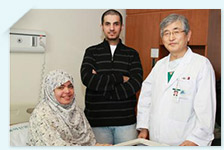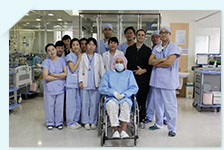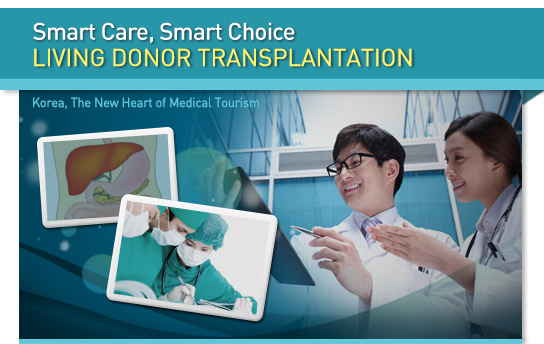 Organ transplantation is often called the “centerpiece of modern medicine,” a
“composite art,” or the “final piece in the puzzle of surgery.” A successful
transplantation requires equal development of all departments such as infectious
diseases, gastroenterology, cardiology, surgery, radiology, laboratory medicine,
pathology and food and nutrition. In this regards, a country with excellent
organ transplantation technique is considered as having high medical technology.
Korea has the world’s best techniques in organ transplantation, especially
living donor transplantation.
Organ transplantation is often called the “centerpiece of modern medicine,” a
“composite art,” or the “final piece in the puzzle of surgery.” A successful
transplantation requires equal development of all departments such as infectious
diseases, gastroenterology, cardiology, surgery, radiology, laboratory medicine,
pathology and food and nutrition. In this regards, a country with excellent
organ transplantation technique is considered as having high medical technology.
Korea has the world’s best techniques in organ transplantation, especially
living donor transplantation.  Other data published by the Korean government (Korea Center for Disease
Control & Prevention) shows that 824 people donated their livers in 2010,
which accounts for 26% out of 3,116 donors in the world. In addition, 77% of
liver transplants were from living donors among the total liver transplants,
while the world’s average was 15%. Korea also recorded 62% in terms of kidney
transplants from living donors, higher than the world’s average of 44%.
Other data published by the Korean government (Korea Center for Disease
Control & Prevention) shows that 824 people donated their livers in 2010,
which accounts for 26% out of 3,116 donors in the world. In addition, 77% of
liver transplants were from living donors among the total liver transplants,
while the world’s average was 15%. Korea also recorded 62% in terms of kidney
transplants from living donors, higher than the world’s average of 44%. In Korea, more than half of the livers (58.6%) were donated by children for their parents. This is a result of Korean culture which values filial piety and respects for parents.
Thanks to such a culture, Korea’s living liver transplant technique which started in 1988 developed substantially though a short history. According to the 2008 yearbook of the Korean Network for Organ Sharing, a 5-year survival rate for living kidney transplants stood at 93.8% and living liver transplants at 77.9%, higher than 80.2% and 68.6% of the U.S. rate, respectively. Currently, around 20 hospitals perform liver transplants and 60 hospitals perform kidney transplants in Korea.
 Fatima Al Ali (female, aged 35) who suffered from juvenile diabetes since she
was 6 had to receive a kidney transplant because her kidney function had
significantly deteriorated due to frequent hemodialysis and transfusion.
Fortunately, the UAE operated a medical system that transfers patients who
cannot be treated in the home country to countries overseas for treatment. The
UAE government requested a kidney transplant for Fatima at a hospital in the
U.S. However, the hospital said “no” because she was a high-risk patient who was
likely to reject the transplant given her medical history.
Fatima Al Ali (female, aged 35) who suffered from juvenile diabetes since she
was 6 had to receive a kidney transplant because her kidney function had
significantly deteriorated due to frequent hemodialysis and transfusion.
Fortunately, the UAE operated a medical system that transfers patients who
cannot be treated in the home country to countries overseas for treatment. The
UAE government requested a kidney transplant for Fatima at a hospital in the
U.S. However, the hospital said “no” because she was a high-risk patient who was
likely to reject the transplant given her medical history. The UAE government also requested the procedure at the ASAN Medical Center in Seoul because of the hospital’s excellent technique in reducing the risk of transplant rejection. The ASAN Medical Center accepted the request and Fatima came to Korea in January 17, 2011 with her brother Khaled Al Ali (male, aged 24). Fatima received various pre-op treatments to reduce the possibility of rejection and underwent surgery on February 1. She recovered quickly from the surgery. She could have normal meals and walk in just one week. She returned to her home two weeks later.
She said that “when I heard that the American hospital could not give me the transplant, I was really disappointed. But, I was not concerned because I was told that the ASAN Medical Center has the best technique in the world. When I return home, I will definitely recommend Korea’s medical techniques.”
 ASAN Medical Center in Korea performed the greatest number of living kidney
transplants in the world in 2011. In 2011 alone, the hospital performed 202
kidney transplants from living donors. It is the only hospital which operates
more than 200 kidney transplants a year for four consecutively years in Asia.
The hospital successfully performs surgeries which require a high-level
technique and has an intensive patient management system. Coordinators from
Japan, China, Uzbekistan and Syria are present at the hospital.
ASAN Medical Center in Korea performed the greatest number of living kidney
transplants in the world in 2011. In 2011 alone, the hospital performed 202
kidney transplants from living donors. It is the only hospital which operates
more than 200 kidney transplants a year for four consecutively years in Asia.
The hospital successfully performs surgeries which require a high-level
technique and has an intensive patient management system. Coordinators from
Japan, China, Uzbekistan and Syria are present at the hospital.  Michael Milne (male, aged 47), an English teacher in a provincial town in
Korea was first brought to the emergency room at Pusan National University
Yangsan Hospital in September 2011. After that, he received a through medical
checkup in December due to repeated symptoms such as difficulty breathing,
abdominal inflation, coughing and edema. He was diagnosed with hepatocirrhosis.
In his case, the disease progressed faster than normal. He had to get a liver
transplant as soon as possible. Otherwise, he could have liver failure and
hepatic coma.
Michael Milne (male, aged 47), an English teacher in a provincial town in
Korea was first brought to the emergency room at Pusan National University
Yangsan Hospital in September 2011. After that, he received a through medical
checkup in December due to repeated symptoms such as difficulty breathing,
abdominal inflation, coughing and edema. He was diagnosed with hepatocirrhosis.
In his case, the disease progressed faster than normal. He had to get a liver
transplant as soon as possible. Otherwise, he could have liver failure and
hepatic coma. His brother Randall (male, aged 43), public official at the Ministry for the Environment in New Zealand rushed to Korea as soon as he heard the news. Randall wanted to offer new life to his brother and decided to offer his liver. Randall was found to have a fatty liver through examination, so he exercised to lose weight before surgery.
Pre-op examination also found that Michael’s blood type was Rh –O while Randall’s blood type was Rh+ O. It was worrisome because different Rh values may destroy red blood cells, but it was confirmed through a thorough test that such a response would not occur.
Finally, they underwent surgery in Korea on December 7, 2011. After a 20-hour long surgery, 70% of Randall’s liver was transplanted to Michael. The surgery was successful. Randall was discharged in just two weeks and returned to home. He said that “I am so happy that my brother regained his health and we can spend New Year’s holiday together in New Zealand with other family members. I expected the worst and decided to stay with him until his last moment. I appreciate the medical staff’s excellent technique. And I also thank the nurses for their hospitality. I could feel their kindness even though we speak different language.”
 Since its foundation in May, 2010, the hospital conducted 40 liver
transplants for a year and half. With a 96% success rate, the hospital has not
experienced a single hepatic artery and biliary stricture, which are common
responses among liver transplant patients. Recipients did not have complications
as well. As a JCI accredited hospital, it offers a detailed explanation about
the success rate, the death rate and the cause of death to international
patients who are not familiar with living donor transplantations and checking
patients’ health thoroughly.
Since its foundation in May, 2010, the hospital conducted 40 liver
transplants for a year and half. With a 96% success rate, the hospital has not
experienced a single hepatic artery and biliary stricture, which are common
responses among liver transplant patients. Recipients did not have complications
as well. As a JCI accredited hospital, it offers a detailed explanation about
the success rate, the death rate and the cause of death to international
patients who are not familiar with living donor transplantations and checking
patients’ health thoroughly.  In Korea, every mountain with fresh air and beautiful scenery has a temple.
Recently, temples which focused on religious activities began running temple
stay programs for the general public and tourists from aboard. Visitors stay at
a temple for 2 or 4 days, eating meals with monks and participating in
meditation. Temple stay which allows people to look after themselves becomes
popular as the program purifies one’s fatigued body and soul regardless of the
participants’ religion.
In Korea, every mountain with fresh air and beautiful scenery has a temple.
Recently, temples which focused on religious activities began running temple
stay programs for the general public and tourists from aboard. Visitors stay at
a temple for 2 or 4 days, eating meals with monks and participating in
meditation. Temple stay which allows people to look after themselves becomes
popular as the program purifies one’s fatigued body and soul regardless of the
participants’ religion. Korea’s largest temple, Tongdosa Temple. The temple is one of the most famous temples for temple stays and other temples such as Gilsangsa temple in Seoul, Woljeongsa Temple in Gangwon and Donghwasa Temple in Daegu have such programs as well. For more information,








댓글 없음:
댓글 쓰기